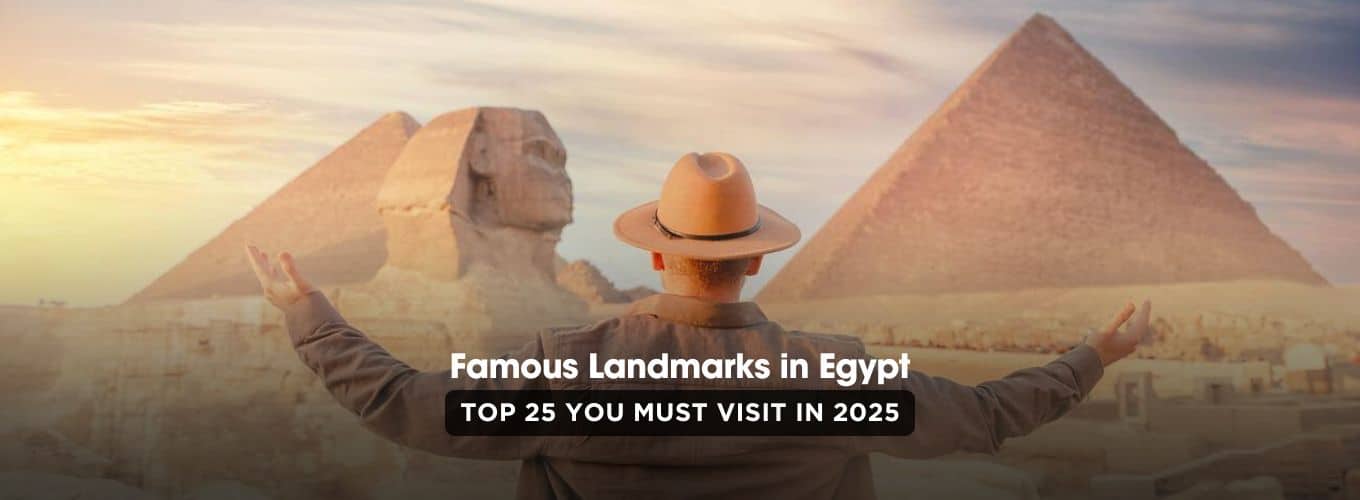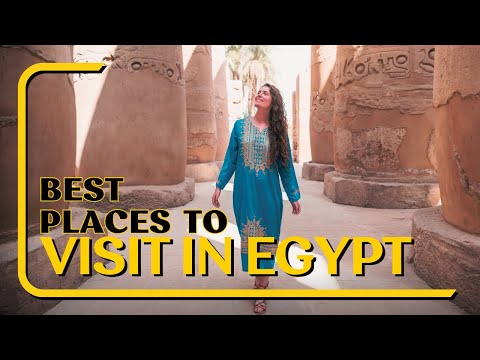Are you ready to step back in time to explore the famous landmarks in Egypt one of the world’s oldest civilizations? Egypt offers an unmatched journey through its rich history, captivating architecture, and natural beauty. Whether you’re an avid historian, an architecture enthusiast, or simply an explorer at heart, this land of pharaohs has something extraordinary for you.
In this post, we’ll uncover 25 of the most famous landmarks in Egypt, from iconic ancient structures to hidden gems. You’ll learn about their historical significance, cultural importance, and practical tips for visiting. Let’s embark on a virtual journey to Egypt’s most treasured landmarks and inspire your next adventure!
Key Takeaways:
- Egypt is home to an unparalleled collection of ancient and modern landmarks that attract millions of tourists annually.
- This guide features the 25 most famous Egyptian landmarks, from ancient wonders to cultural treasures.
- Highlights include iconic sites like the Great Pyramids, Abu Simbel Temples, and the Valley of the Kings.
- Each landmark is steeped in history, cultural importance, or architectural brilliance.
- This article is your ultimate resource for planning an unforgettable all inclusive trip to Egypt in 2025.
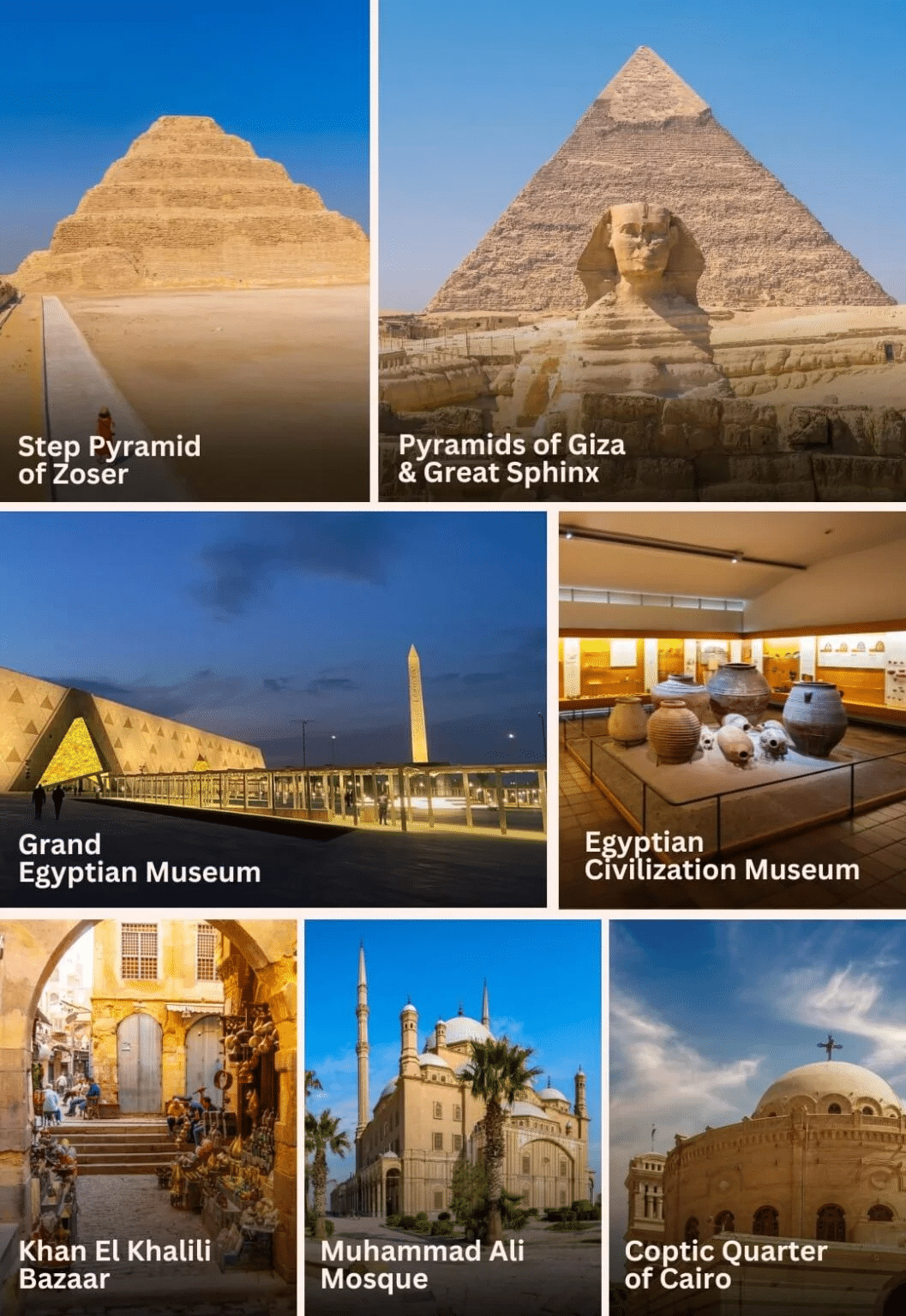
1. Pyramids of Giza
If there’s one place on Earth that screams “ancient mystery and human ingenuity,” it’s the Pyramids of Giza. These structures, built over 4,500 years ago, are engineering marvels. The Great Pyramid of Khufu was the tallest man-made structure for over 3,800 years.
You’ll want to explore the Great Pyramid and take photos of the Sphinx. It’s smaller than you might think. You might also enjoy a camel ride nearby. For a special experience, stay for the Sound and Light Show at night. It’s cheesy but magical, with the pyramids lit up against the sky.
Pro tip: If you want fewer crowds, arrive early in the morning or just before closing. And don’t forget to haggle if you’re buying souvenirs; bargaining is half the fun!
2. The Great Sphinx of Giza
The Great Sphinx—is one of the most famous landmarks in Egypt and mysterious statues in the world. This half-lion, half-human creature has stood watch over the Giza Plateau for thousands of years, silently guarding the pyramids and sparking endless theories about its origins. When you stand in front of the Sphinx, it’s hard not to feel small in comparison. It’s only about 66 feet tall, but its sheer scale and the mysterious expression on its face will leave you awestruck. You’ll notice its nose is missing—some say it was shot off by a cannon during a battle, but who knows for sure?
Here’s a fun tip: If you’re visiting in the summer, it’s worth getting there early in the morning. Not only will you beat the crowds, but the light in the morning makes the Sphinx look even more majestic. Take a moment to just sit and stare—its gaze will make you feel like you’re in the presence of something ancient and otherworldly.
3. Valley of the Kings
The Valley of the Kings is like stepping into ancient Egypt’s royal past. It’s on the west bank of the Nile. Here, you find the tombs of Egypt’s most powerful pharaohs, like Tutankhamun. Walking through, you feel like you’re in a history book. Each tomb has secrets, treasures, and stories that last thousands of years.
There are over 60 tombs in the valley. Some are huge, with detailed paintings and hieroglyphics. Others are small and simple. King Tut’s tomb is the biggest hit. Its discovery in 1922 was huge. Inside, treasures like his golden mask were found. It amazed the world.
Tip: Don’t rush through the valley—take your time to soak in the details. And if you can, splurge on the tomb of Ramses VI—it’s known for its stunning colors and artwork. One more thing: bring a hat and sunscreen because it gets hot.
4. Abu Simbel Temples
Abu Simbel is a breathtaking sight that feels like stepping back in time. Located in southern Egypt, the two temples were carved by Pharaoh Ramses II in the 13th century BC. The amazing thing is that the entire complex was moved in the 1960s. This was to save it from flooding caused by the Aswan High Dam.
The four giant statues of Ramses II at the temple’s entrance are truly awe-inspiring. Each statue is about 66 feet tall, making it larger than many buildings. Inside, the temple is stunning, with detailed carvings and chambers that align with the sun. Twice a year, the sun shines through the temple, lighting up the statues of Ramses and the gods.
Pro tip: Abu Simbel is a bit out of the way, so if you’re planning to visit, consider flying in from Aswan. It’s a bit of a trek, but trust me, it’s worth it. Also, don’t forget your camera—the views here are incredible.
5. Karnak Temple
Karnak Temple is like a huge open-air museum in Egypt. It’s in Luxor and covers over 200 acres. It’s the biggest religious complex in the world and one of the most famous landmarks in Egypt. When you enter, you’re surrounded by huge columns, massive obelisks, and detailed carvings.
The temple was for Amun-Ra, the king of the gods. Many pharaohs added to it over 2,000 years. Each one left their mark. The Hypostyle Hall is the temple’s highlight. It has 134 giant columns, each as tall as a 10-story building. Walking through feels like a stone forest. Don’t miss the Sacred Lake. It reflects the temple beautifully, best at sunrise or sunset.
A pro tip: If you want to beat the crowds, try to visit early or later in the day. And if you’re a history buff, the light show at night is a must-see. It brings the temple to life, illuminating its colossal statues and walls while narrating its epic history. Trust me, you’ll feel like you’ve traveled back in time.
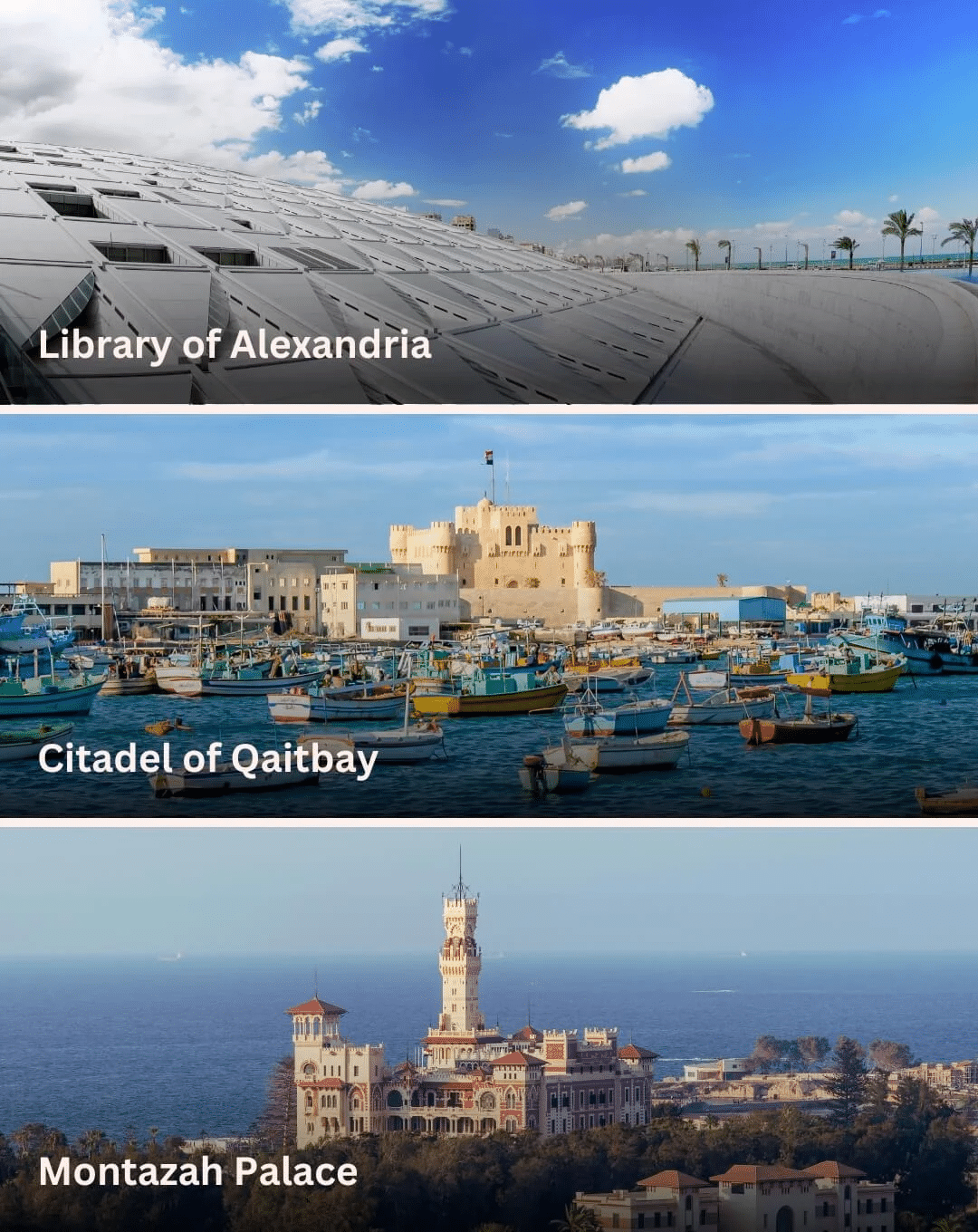
6. Luxor Temple
Luxor Temple is one of those places that will leave you completely awestruck. Unlike other temples in Egypt, it’s not built on a hill or in the desert—it’s right in the heart of modern-day Luxor, making it feel like an ancient gem in the middle of a bustling city. What’s amazing about this temple is how it has survived the centuries while still showcasing the grandeur of Egypt’s ancient splendor.
The temple was dedicated to the Theban Triad of gods: Amun, Mut, and Khonsu. Walking through the entrance, you’re immediately greeted by massive statues of Ramses II and towering obelisks. Inside, the walls are covered with intricate carvings that tell the story of Egypt’s pharaohs and their divine connection to the gods.
If you’re visiting at night, don’t miss the opportunity to see the temple lit up—it’s almost like stepping into a scene from an ancient movie, with the glowing columns and statues giving off an almost mystical vibe.
Pro tip: Visit at sunset or after dark to see Luxor Temple at its most magical. And, if you’re into history, take a guide with you—it’ll bring the temple’s fascinating history to life!
7. The Nile River
The Nile River is truly the heartbeat of Egypt. Without it, this ancient civilization would never have flourished. Stretching over 4,000 miles, the Nile is the longest river in the world, and it has been Egypt’s lifeline for millennia. The river provides water, transportation, and fertile land in a country that’s mostly desert. In ancient times, the Nile’s annual flooding brought nutrient-rich silt that allowed crops to grow, making it possible for Egypt to sustain its massive population.
Today, the Nile is just as essential. You’ll find boats, ferries, and even luxury cruises gliding along its waters, offering a unique view of Egypt’s most famous sites. A boat ride on the Nile isn’t just a trip—it’s a step back in time. As you float past temples and villages, you’ll get a sense of how deeply intertwined the river is with Egypt’s culture and history.
Pro tip: If you’re planning a Nile cruise, try to book a trip from Luxor to Aswan. It’s the best way to see the temples along the river, and the scenery is incredible. And make sure to pack your camera—sunsets on the Nile are something else.
8. Alexandria’s Bibliotheca
Alexandria’s Bibliotheca is a modern beacon of knowledge, giving us goosebumps. It honors the ancient Library of Alexandria, once the world’s largest and most significant. This sleek, futuristic building symbolizes the revival of knowledge. The original library, founded in the 3rd century BC, was a center for scholars and philosophers. Sadly, it was destroyed. But the Bibliotheca continues its legacy.
The building is a modern architectural masterpiece. Its tilted roof looks like the sun. Inside, it holds millions of books, manuscripts, and digital archives. It’s more than a library. It’s a cultural center with museums, art galleries, and lecture halls. Walking in, you feel history’s weight and the thrill of discovery.
Pro tip: Spend some time in the reading rooms—they offer an amazing view of the Mediterranean. And if you’re a history geek, check out the rare collection of ancient texts and scrolls on display. It’s like time-traveling to the age of Greek philosophers and early scientists.
9. White Desert
The White Desert is one of Egypt’s best-kept secrets. It feels like stepping into another world. The endless white sand and salt flats seem to stretch forever. Located in the western desert, it’s a dream for photographers. The light at sunrise or sunset makes the salt crust glow magically.
The White Desert is unlike any other desert. Its beauty is eerie and otherworldly. Instead of golden sands, it’s covered in glistening salt deposits. Strange rock formations dot the landscape. You might see desert foxes or gazelles. They somehow thrive in this harsh beauty. It’s incredibly quiet here. You’ll find peace in the silence and the stunning views.
Pro tip: If you’re planning to visit, go with a guided tour—things can get tricky in the desert. And if you’re into stargazing, stay overnight in a desert camp; the night sky is unbelievable, with stars so bright, they’ll make you feel like you’re floating in space.
10. Mount Sinai
Mount Sinai is not just a beautiful natural wonder. It’s also a sacred place for many. It’s where Moses is thought to have gotten the Ten Commandments. This mountain is a special spot for Christians, Jews, and Muslims.
It stands at 7,497 feet, giving amazing views of the desert and mountains. Climbing it is tough but very spiritual. The hike is a journey to the top, starting in the dark. Hikers aim to reach the summit by sunrise. The view of the Sinai Peninsula at sunrise is breathtaking. The golden light on the peaks makes the climb feel magical. On your way up, you’ll see small chapels, ancient writings, and bedouin stalls. They sell tea and snacks. It’s a unique experience.
Pro tip: Be sure to bring a flashlight for the night hike and wear sturdy shoes—it’s a steep climb! Once you reach the summit, take a moment to reflect; the peaceful atmosphere is something you’ll remember long after the hike. And if you’re up for it, visit St. Catherine’s Monastery at the base of the mountain—it’s a UNESCO World Heritage site with incredible history.
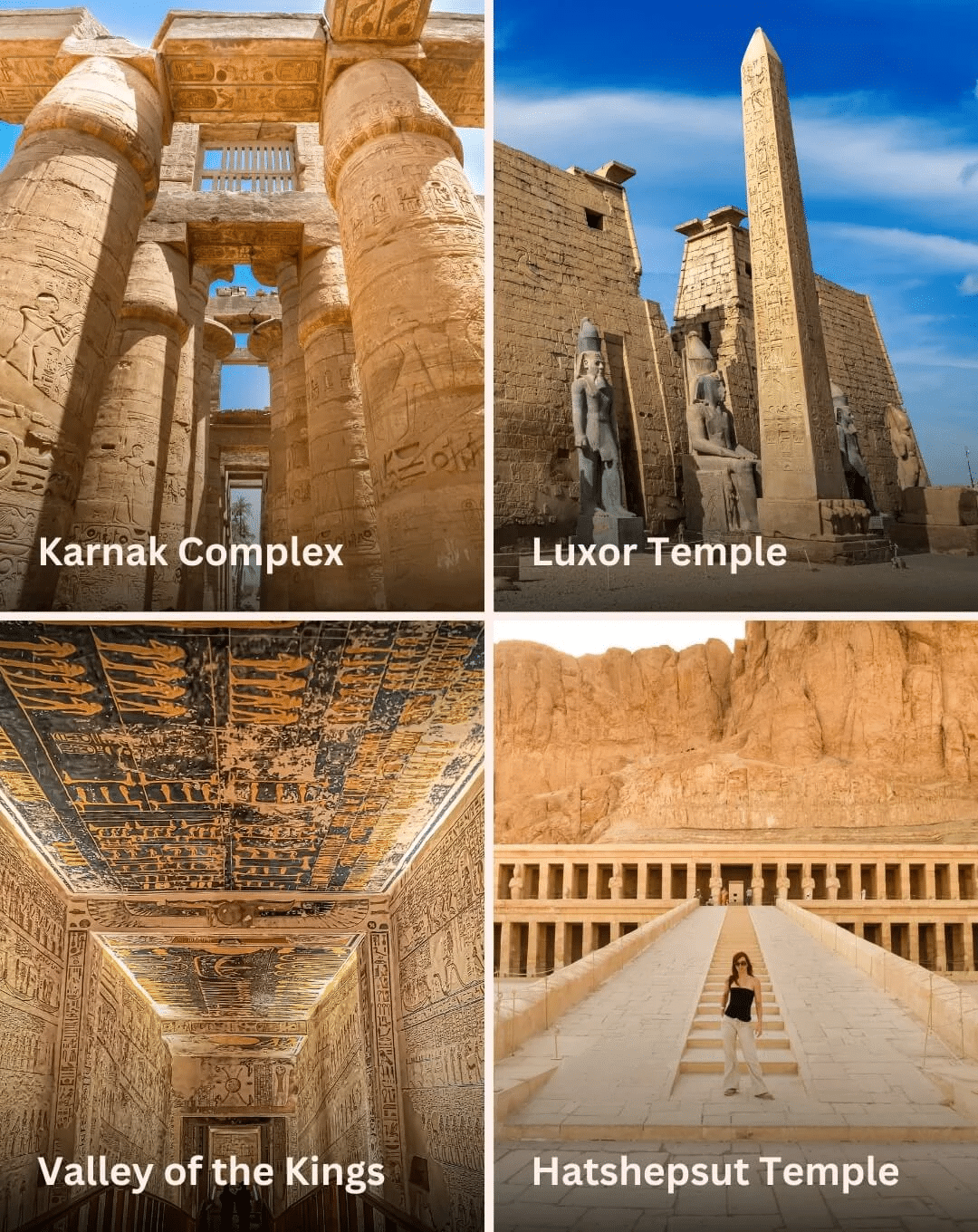
11. Egyptian Civilization Museum
The Egyptian Civilization Museum in Cairo is a must-see for history buffs. Opened in 2022, it showcases over 50,000 artifacts. This modern marvel offers a deep dive into Egypt’s rich past. The museum’s sleek design stands out against the ancient treasures inside. You’ll feel like you’re stepping back in time. The collection includes mummies of Egypt’s New Kingdom pharaohs.
There are also statues, pottery, and personal items from different dynasties. These artifacts give a peek into the lives of ancient Egyptians. The museum’s layout guides you through Egypt’s history in a clear, chronological order.
Pro tip: To get the most out of your visit, consider hiring a guide. They can offer incredible insights into the artifacts and help you understand the significance behind the pieces. And don’t forget to visit the interactive exhibits—they bring ancient history to life in a way you won’t find anywhere else!
12. Siwa Oasis
Siwa Oasis is a hidden gem in Egypt, a peaceful escape from Cairo or Luxor’s hustle. It’s deep in the Western Desert, near Libya. Here, lush palm groves, salt lakes, and ancient ruins surround you, creating a magical paradise.
The Siwan people’s unique culture is a highlight. They speak Berber and keep ancient traditions alive. History buffs will love the Temple of the Oracle of Amun, where Alexander the Great sought answers. Siwa’s old town, with its mudbrick architecture, is also a must-see.
Pro tip: Siwa’s remote location means it’s not the easiest place to get to, but it’s worth the journey. You can hire a 4×4 for a desert tour or travel by bus from Cairo. Once you’re there, be sure to visit Cleopatra’s Bath—a natural spring where you can take a dip in cool, refreshing waters after exploring the desert heat. Trust me, it’s an experience you won’t forget!
13. Aswan High Dam
The Aswan High Dam is a major engineering feat in Egypt, showing human creativity at its best. It sits across the Nile River and was finished in 1970. It has greatly helped Egypt’s economy, farming, and energy use. The dam controls the Nile’s flooding, stores water for crops, and makes electricity. This electricity powers a lot of Egypt.
The dam is huge, over 12,000 feet long and 380 feet tall. When you go there, you can climb to the top for amazing views of Lake Nasser. It’s one of the biggest man-made lakes in the world. But what’s special about the Aswan High Dam is how it changed Egypt’s farming. It turned the desert into land that could grow crops.
Pro tip: Don’t miss the nearby Nubian Museum—it offers fascinating exhibits on the history of the Nubian people, who were displaced by the creation of the dam. Also, if you’re interested in a boat ride, there are tours on Lake Nasser where you can get a closer look at the dam and surrounding area. Just keep in mind—it can get really hot in the summer, so bring plenty of water and sun protection!
14. Temple of Philae
The Temple of Philae is one of the famous landmarks in Egypt and a peaceful ancient site, located on an island in Lake Nasser, near Aswan. Dedicated to the goddess Isis, this temple was originally built on Philae Island but was relocated to its current location in the 1960s to save it from flooding caused by the construction of the Aswan High Dam.
As you approach the temple by boat, the sight of its towering columns and intricate carvings against the backdrop of the lake is breathtaking. Inside, you’ll find beautiful reliefs and hieroglyphics that tell the story of Isis, Osiris, and their mythological journey.
Pro tip: To make the most of your visit, try to go early in the morning or in the late afternoon when the crowds are lighter and the lighting is perfect for photos. The boat ride to the temple is also an unforgettable experience—watching the sunset over the lake is something you won’t want to miss!
15. Dahshur Pyramids
Dahshur Pyramids are often overshadowed by the famous Pyramids of Giza. But they are just as impressive and have a hidden gem vibe. Located about 25 kilometers south of Cairo, this site is home to some of Egypt’s oldest structures.
The Dahshur complex includes two major pyramids: the Bent Pyramid and the Red Pyramid. Both were built by Pharaoh Sneferu during Egypt’s Fourth Dynasty.
The Bent Pyramid is unique with a steep angle that changes to a shallower one. This gives it its signature bent shape. Some think it was a mistake, while others believe it was a deliberate design to prevent collapse.
The Red Pyramid is Egypt’s first true pyramid with smooth sides. It’s also the third largest pyramid in Egypt, after the Great Pyramid of Giza.
Pro tip: The Dahshur Pyramids are less crowded than Giza, so it’s a great spot to explore without the usual hustle. If you want to go inside the pyramids, be prepared for a bit of a climb—it’s narrow and a little cramped, but worth it for the experience. And don’t forget to bring a good camera—the Red Pyramid, especially, is stunning in the golden hour light!
16. Coptic Cairo
Coptic Cairo is a fascinating part of Cairo that shows Egypt’s rich Christian history. It’s in the old city and has ancient churches, monasteries, and museums. This makes it a top spot for history buffs and those curious about Egypt’s religious past.
Here, you’ll find the Hanging Church, one of Egypt’s oldest Christian churches, built in the 3rd century. It’s called the Hanging Church because it’s built over a Roman fortress gatehouse.
The area also has the Coptic Museum, filled with Christian artifacts like ancient manuscripts and icons. The Ben Ezra Synagogue is nearby, giving a glimpse into Egypt’s Jewish heritage.
Pro tip: Take your time exploring the narrow streets of Coptic Cairo, as there are hidden gems everywhere. The atmosphere here is calm and reflective—perfect for soaking in the historical significance of the place. If you’re a fan of ancient architecture, don’t miss the Monastery of St. George—it’s less crowded and filled with amazing artwork!
17. Islamic Cairo
Islamic Cairo feels like stepping into a history book come to life. This UNESCO World Heritage site is filled with Islamic architectural wonders. You’ll see grand mosques and ancient madrasas (schools).
It’s the core of Cairo’s Islamic heritage. Here, culture, art, and history blend in a mesmerizing way. The Sultan Hassan Mosque stands out, with its huge minarets and detailed stonework. Close by, the Al-Rifa’i Mosque offers a modern twist.
Exploring Islamic Cairo is like strolling through a museum. The Khan el-Khalili Bazaar is a vibrant market. It’s great for finding souvenirs and experiencing Cairo’s energy. History lovers should visit the Mosque of Ibn Tulun. It’s one of Cairo’s oldest mosques and a stunning architectural gem.
Pro tip: Wear comfortable shoes because Islamic Cairo is best explored on foot. Don’t forget to haggle a little at the market, but be polite about it! And if you’re in the mood for something unique, head to a traditional coffeehouse to try Egypt’s famous Turkish coffee. It’s strong, rich, and perfect for sitting back and people-watching!
18. Temple of Kom Ombo
The Temple of Kom Ombo is one of the most unique temples in Egypt, thanks to its dual design. Located along the Nile between Aswan and Luxor, this temple is dedicated to two gods: Horus the Elder, the falcon-headed god of the sky, and Sobek, the crocodile god associated with fertility and the Nile. The temple is built symmetrically, with two entrances, two sanctuaries, and even two sets of halls and columns—one side devoted to Horus and the other to Sobek.
The temple’s architecture is stunning, with intricately carved reliefs and towering columns. You’ll see depictions of both gods, as well as fascinating scenes of ancient Egyptian medical practices, like surgical instruments and treatments, which are thought to have been recorded for religious purposes. Another highlight? The nearby crocodile museum, where you can learn about the sacred animals worshipped here.
Pro tip: The temple is beautifully lit at night, so if you have the chance, try to visit during the late afternoon or evening to see it in a completely different light. Don’t forget to take a walk along the Nile nearby—you’ll often spot local fishermen and perhaps even some crocodiles!
19. Monastery of Saint Catherine
Nestled at the foot of Mount Sinai, the Monastery of Saint Catherine is one of the oldest working Christian monasteries in the world. Founded in the 6th century by Emperor Justinian, this UNESCO World Heritage site has been a pilgrimage destination for centuries, drawing visitors with its deep historical and spiritual significance. The monastery is dedicated to Saint Catherine of Alexandria, and legend has it that her body was brought here by angels after her martyrdom.
When you visit, you’ll be struck by the peaceful and serene atmosphere. The monastery’s ancient walls are home to an extraordinary collection of religious icons, manuscripts, and frescoes. Inside the Church of the Burning Bush, you’ll find one of the most famous icons in the Christian world—a depiction of the burning bush that Moses encountered.
Pro tip: If you’re up for an adventure, consider hiking to the top of Mount Sinai for a stunning sunrise or sunset. The view is breathtaking and adds to the spiritual experience. You can also visit the monastery’s library, which holds priceless ancient texts. But be prepared—it’s a remote location, so wear sturdy shoes and bring plenty of water!
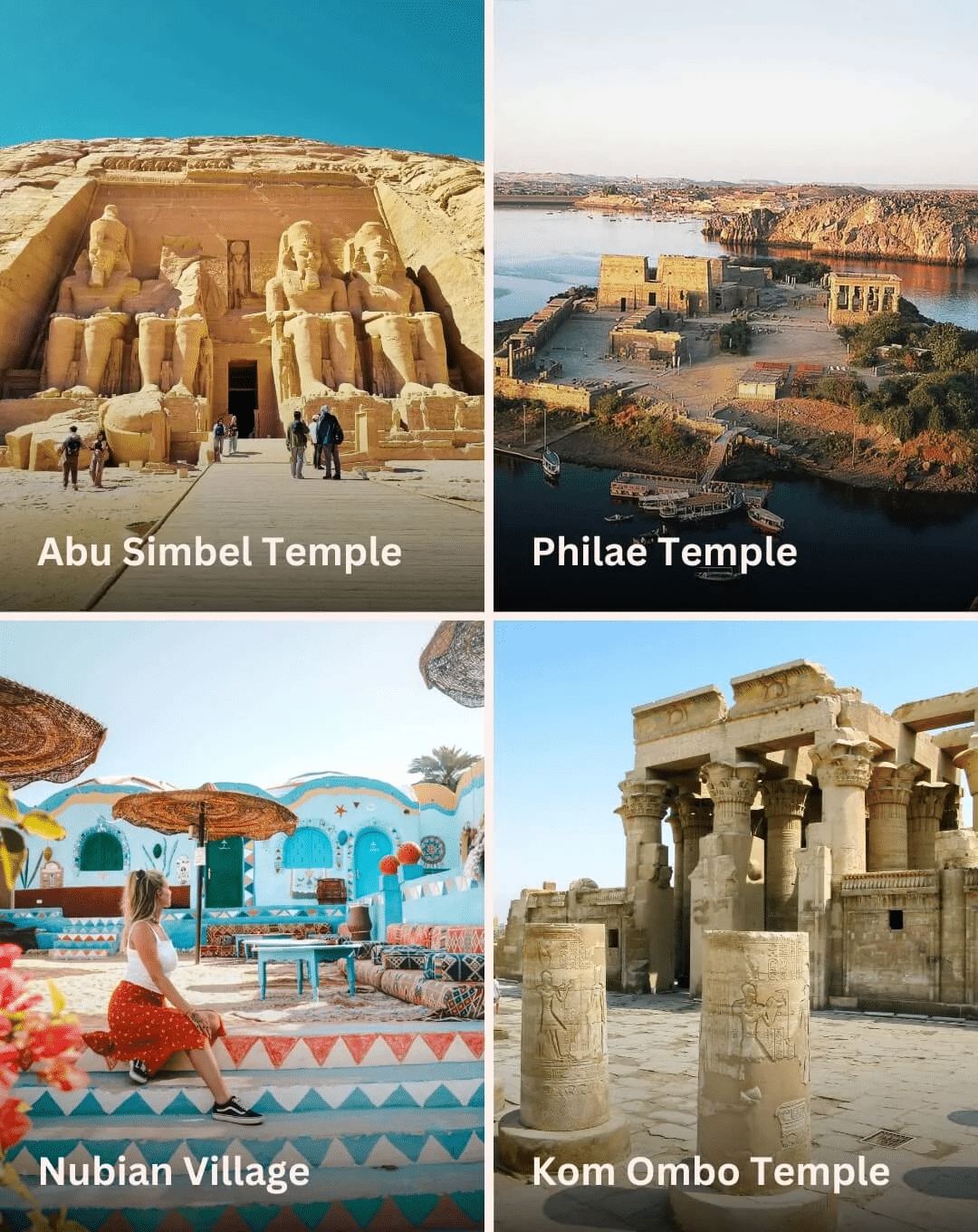
20. Colossi of Memnon
The Colossi of Memnon are two massive statues that stand proudly on the west bank of the Nile, near Luxor. These monumental figures, each around 60 feet tall, represent the Pharaoh Amenhotep III, who ruled during Egypt’s 18th dynasty. Originally, the statues flanked the entrance to a grand mortuary temple, which has long since been destroyed, leaving just these awe-inspiring remnants behind.
The Colossi are made from limestone and were once covered in vibrant colors, but today, they stand as silent sentinels, weathered by centuries of wind and sand. What makes them even more fascinating is the myth that one of the statues “sang” at dawn—this phenomenon was likely caused by the vibrations from the sun warming the stone, but it captured the imagination of ancient travelers, earning the statues the nickname “Memnon.”
Pro tip: The Colossi are best visited early in the morning when the crowds are thin and the light is perfect for photos. They’re located near the Valley of the Kings, so you can easily combine a visit to both. Don’t forget to snap a photo and take a moment to appreciate the scale of these ancient giants—they truly put the power of ancient Egypt into perspective!
21. Khan El Khalili & Al-Muizz Street
If you’re looking to immerse yourself in the vibrant heart of Cairo, Khan El Khalili and Al-Muizz Street are absolute must-sees. Located in the Islamic Cairo district, these two spots offer a captivating blend of history, culture, and shopping.
Khan El Khalili is Cairo’s most famous bazaar, where you’ll find everything from intricate jewelry and spices to beautiful textiles and handcrafted souvenirs. The narrow, bustling alleyways are lined with shops, cafes, and street vendors, creating a lively and colorful atmosphere. Don’t be afraid to haggle—it’s part of the experience!
Just a short walk away, Al-Muizz Street is one of the oldest and most historically significant streets in Cairo. Lined with stunning Islamic architecture, it’s like stepping back in time. You’ll see ancient mosques, palaces, and madrasas (schools) that date back to the Fatimid, Ayyubid, and Mamluk eras.
Pro tip: Make sure to take a break at one of the traditional coffeehouses along the street for a cup of Turkish coffee or mint tea. The street is less crowded in the late afternoon, so that’s the perfect time for a more relaxed stroll and a bit of people-watching. Just be ready to get lost in the maze of shops and alleys—it’s part of the fun!
22. Edfu Temple
The Temple of Edfu is one of the famous landmarks in Egypt. It’s dedicated to the falcon-headed god Horus. It’s found on the Nile’s west bank, between Luxor and Aswan. This ancient wonder shows off Ptolemaic architecture.
Built from 237 to 57 BCE, it’s the second-largest temple in Egypt. It gives visitors a peek into Egypt’s lively religious life. When you get close to the temple, its tall pylons and grand entrance catch your eye. They lead to a big courtyard. The walls inside are covered in beautiful hieroglyphs.
These hieroglyphs tell the tale of Horus’ fight against his uncle Set. The sanctuary at the temple’s back is where Horus’ statue once was. It’s a sacred place for many visitors today.
Pro tip: Edfu is less crowded compared to other major temples, so it’s a peaceful spot to explore. If you’re visiting during the day, the sunlight creates beautiful shadows on the temple’s carvings, making it a photographer’s dream. Be sure to take your time and really appreciate the detailed reliefs—they offer fascinating insights into ancient Egyptian mythology and rituals.
23. Red Sea Coral Reefs
The Red Sea Coral Reefs are a vibrant underwater wonderland and one of Egypt’s most treasured natural wonders. They stretch along Egypt’s coastline from Sharm El Sheikh in the north to Marsa Alam in the south. The clear, warm waters make it perfect for snorkeling and diving.
Under the surface, you’ll see an incredible variety of coral species and schools of bright tropical fish. You might even spot a sea turtle or dolphin. Famous dive spots include Ras Mohammed National Park near Sharm El Sheikh and the reefs around Hurghada and Marsa Alam.
Pro tip: The best time to visit the Red Sea for diving or snorkeling is between October and April when the water is warmer and visibility is better. If you’re new to diving, there are plenty of beginner-friendly spots and dive shops that offer courses. Don’t forget your underwater camera to capture the vibrant marine life—trust me, you’ll want to share these photos!
24. Citadel of Qaitbay
The Citadel of Qaitbay is a stunning historical landmark perched on the Mediterranean coastline in Alexandria. Built-in the 15th century by Sultan Qaitbay to protect the city from sea invasions, the citadel is one of the finest examples of Islamic military architecture in Egypt. Its strategic location on the site of the ancient Pharos Lighthouse, one of the Seven Wonders of the Ancient World, gives it a dramatic and picturesque backdrop, with the sea stretching out in every direction.
The citadel itself is an impressive fortress, featuring high stone walls, imposing towers, and a large courtyard. Inside, you can explore the ancient walls, learn about Alexandria’s maritime history, and take in panoramic views of the Mediterranean Sea from the top of the towers.
Pro tip: The Citadel is particularly beautiful at sunset when the colors of the sky and sea blend, creating a perfect photo opportunity. If you’re in Alexandria, it’s a great spot to explore, and it’s close to other attractions, like the Alexandria Library. Be sure to take a walk along the nearby coastline and enjoy the atmosphere of this historic city!
25. Grand Egyptian Museum
The Grand Egyptian Museum (GEM) is near the Giza Pyramids. It’s one of the most awaited and impressive museums globally. Set to open fully in 2025, it will house over 100,000 ancient Egyptian artifacts.
Many of these artifacts belong to Tutankhamun and have never been seen by the public before. The museum’s modern design matches the ancient history it displays. It’s a top spot for history lovers and those curious about ancient Egypt.
The GEM’s collection covers all of Egyptian history, from the Old Kingdom to the Greco-Roman period. Highlights include massive statues, mummies, and detailed jewelry. The exhibit of King Tut’s treasures is a major attraction.
Pro tip: To avoid the crowds, try visiting early in the morning. The museum’s expansive layout means there’s plenty to see, so make sure to wear comfortable shoes! You can also combine your trip with a visit to the nearby Pyramids of Giza and Sphinx for a full day of exploration into Egypt’s ancient wonders.
Tips for Visiting Egyptian Landmarks
Visiting famous landmarks in Egypt is a dream come true, but to make the most of your trip, here are some tips to ensure your experience is smooth and enjoyable.
- Stay Hydrated & Prepare for the Heat: Egypt is hot—especially in the summer months! Always carry water with you, wear sunscreen, and dress in light, breathable clothing. The sun can be intense, so a wide-brimmed hat and sunglasses will be your best friends.
- Respect the Culture: Egypt is a conservative country, so it’s important to dress modestly when visiting religious sites like mosques and temples. For women, covering the shoulders and knees is recommended. Men should avoid wearing shorts in these areas.
- Arrive Early to Beat the Crowds: Many of Egypt’s most famous sites, like the Pyramids of Giza or the Valley of the Kings, can get very crowded. Arriving early in the morning will allow you to enjoy the landmarks with fewer people around and better lighting for photos.
- Use Comfortable Shoes: Egypt’s landmarks often involve a lot of walking, sometimes on uneven surfaces or sandy paths. Be sure to wear sturdy, comfortable shoes—especially when visiting archaeological sites like the Valley of the Kings or Abu Simbel.
- Don’t forget to Bargain: If you’re shopping in bazaars like Khan El Khalili, don’t be afraid to haggle! It’s part of the experience, and you might just score a great deal. Always start by offering less than the asking price and work your way up.
- Take Your Time: Egypt’s landmarks have a rich history, and rushing through them won’t do them justice. Take the time to soak in the details of the ancient art, architecture, and surroundings. After all, you’re standing in places that have stood for thousands of years!
Conclusion to Egyptian Landmarks
Famous Landmarks in Egypt are more than just historical sites; they are timeless gateways to an ancient world filled with wonder and awe. From the grandeur of the Great Pyramids to the surreal beauty of the White Desert, these 25 landmarks tell the story of a civilization that continues to captivate the world.
Planning your journey to Egypt? Let this guide inspire your itinerary, and immerse yourself in the magic of a land where history, culture, and natural beauty intertwine. Book your trip now and experience Egypt in a way you’ll never forget!
Related travel guide to read:
